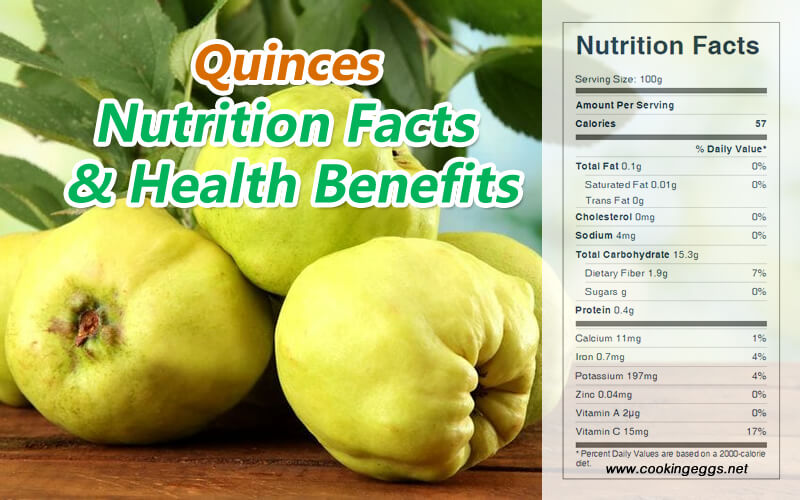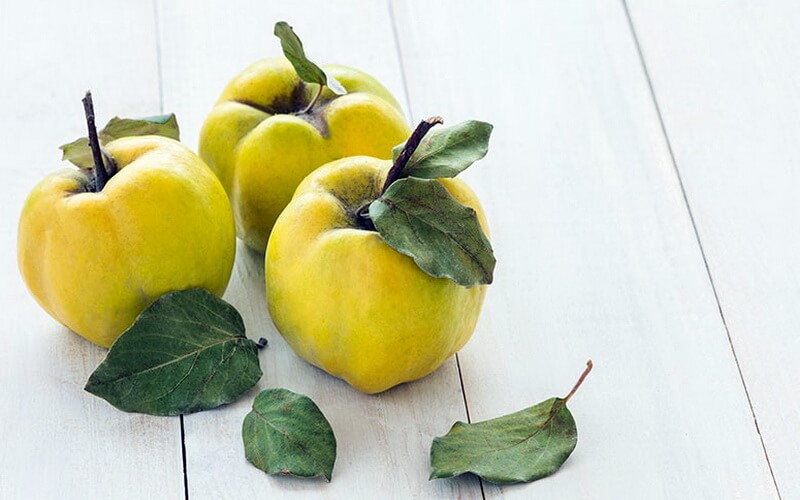Quince Fruit Nutrition Facts and Health Benefits
Warning: A non-numeric value encountered in /www/wwwroot/www.cookingeggs.net/wp-content/plugins/nutrition-facts-label/nutrition-facts-label.php on line 384
The quince (Cydonia oblonga) is a golden-yellow pome fruit that belongs to the Rosaceae family with many health benefits. Ripe quince has a pleasant, lasting, and powerful flavor. Quince cannot be eaten raw and requires cooking to be edible.
The quince is a native of Western Asia and has a long history of cultivation in the Middle East and throughout the Mediterranean region. The quince fruit looks like a large, lumpy yellow pear with smooth or woolly down skin depending on the variety. A characteristic common to all varieties is their strong aromatic fragrance, a musky-wild, tropical-like perfume. Because of the quince’s dry, hard texture and its astringent flavor, it is better consumed cooked than raw. Before being cooked, quince must be peeled and placed in a mixture of water and lemon juice to prevent discoloration. When cooked, the hard pulp of the fruit softens, turns pink, and takes on the texture of a pear. The flavor becomes more mellow and sweeter.
The quince is a member of the same family as apples and pears. The mature fruit ranges in size and shape from that of a small plum to that of a large pear, depending on variety. The two most common varieties of American quince are the pineapple quince and the perfumed quince. The pineapple quince is round and has a yellow skin and white flesh that is somewhat dry. The flavor is similar to that of pineapple. The perfumed quince is the shape of a small football and has a tart flesh. The Japanese quince has a slightly more acidic flavor. Several small varieties are often used for bonsai plants.

Nutritional Value of Quinces
Quince is a good source of nutrients, vitamins, and minerals, having high nutritional value and potentially having positive effects on human health. The quince is a good source of ascorbic acid, contains high levels of pectin, has low fat content, and is an important source of organic acids, sugars, crude fiber, and minerals, such as potassium, phosphorous, and calcium.
Quince is 84% water, 15% carbohydrates, and contains negligible fat and protein. In a 100-gram reference amount, raw quince provides 57 calories, 15.3 g carbohydrate, 0.4 g protein, 0.1 g fat, 1.9 g dietary fiber, 40 IU vitamin A, 15 mg vitamin C, 197 mg potassium, 4 mg sodium, 17 mg phosphorus, 11 mg calcium, 8 mg magnesium, and 0.7 mg iron.
Raw Quince Nutrition Facts Label
Health Benefits of Quinces
Intestinal Health
Quinces are especially high in pectin, a soluble fiber that helps prevent various types of digestive-related issues and gastrointestinal problems. By virtue of providing a medium for bacterial growth, pectin will increase the bacterial mass in the colon by virtue of its ability to fermentable fibers are consumed by the microbiota within the large intestines, mildly increasing fecal bulk and producing short-chain fatty acids as byproducts with wide-ranging physiological activities. This fermentation influences the expression of many genes within the large intestine, which affect digestive function and lipid and glucose metabolism, as well as the immune system, inflammation and more.
Prevents Diabetes
According to research findings, quince juice is very effective against diabetes and urinary problems, and quince leaves can be used by diabetic patients to decrease the complications of diabetes. A long-term remedy with quince leaves can be useful for people with type 2 diabetes mellitus. Furthermore, the fibers in quince play an important role in lowering cholesterol levels. This lowers the risks of cardiovascular diseases, diabetes and obesity.
Improving Cardiovascular Health
Research shows that phenolics are the main hydrophilic compounds with antioxidant activity in peel and pulp quince tissues. Quince leaf has potent antioxidant activity and may have some effect on cardiovascular disease. Quince can be used as a great natural and cheap source of bioactive compounds with primary antioxidative properties along with other mechanisms of action. By modulating various cardiovascular risk factors, such as atherosclerosis, smoking, endothelial dysfunction, hypertension, diabetes, and hyperhomocysteinaemia, quince leaf extract may have relevance in the prevention and treatment of different pathological states of ischemic, inflammatory, and hypertrophic heart disease.
Protect Skin
Quince is highly rich in phenolic compounds, which are very beneficial for our skin health and prevent various types of skin-related diseases. It softens skin in the case of chapped lips and skin, crevasses or burns. Quince contains antioxidants that help to eliminate the damage that free radicals cause to skin cells, reducing the appearance of wrinkles, removing blemishes, protecting our skin from bacterial infection, and preventing acne and pimples. It is also used as an adjunct to skin lotions and creams.
Antiinflammatory Effect
With their wealth of vitamin C and soluble fiber, quinces also lower the risk of heart and circulatory diseases. As an antioxidant, it reduces inflammatory symptoms by reacting with histamines and peroxides. Its antioxidant property is associated with the reduction of cancer incidences. Vitamin C helps to boost immunity and aids in the treatment of inflammatory conditions.

Traditional Uses of Quince
- An infusion of the fruits and seeds of quince is used as a demulcent, mucous membrane protector, antidiarrheal agent, and diuretic and has traditionally been indicated to treat gastritis, gastroduodenal ulcers, irritable bowel syndrome, diarrhea, colds, pharyngitis, and bronchitis. Externally, the mucilage derived from soaked seeds is applied directly to the affected area, popularly in cases of anal fissures, sinus cracks, chilblains, hemorrhoids, and scalds.
- The quince juice and jelly have been traditionally used as folk medicine for treating stomach illness.
- Traditionally, the fruit has been used to cure digestive disorders, it promises to inhibit growth of helicobacter pylori, an ulcer causing bacteria in the stomach.
- According to research, quince helps reduce symptoms of early pregnancy such as nausea and vomiting.
- Quince mucilage is used as an external application for scalds and ulcers.
- Quince marmalade has been believed to help digestion, and to comfort or strengthen the stomach.
- In traditional medicine the predominant preparations of quince are juice, infusions, or cooked with cinnamon, lemon, or honey to activate its emollient, astringent, and expectorant properties.
- Dried quince pits are used as a remedy for soreness of throat and for relieving cough. The dried fruit has been used in traditional medicine in the form of hot water extracts, for its antitussive or expectorant properties.
- The quince fruit has been used as carminative, expectorant, anticancer, antibacterial, antidiabetic and laxative agents, and has also been used for the treatment of skin lesions, migraine, cold, influenza, inflammatory bowel disease, and conjunctivitis, among other disorders.
- Quince helps against respiratory disorders like asthma.
- Homemade medicines from Chinese quince fruit (including fruit liquor, decoction, syrup, and paste) have been said to have antitussive, expectorant, antispasmodic, and antidiuretic actions, and have been used against respiratory infections, intestinal dysregulation, and diuresis, and for treating people with a weak general health.
- Sweet quince has been introduced as an antidepressant, ardiotonic, neuroprotective, diuretic, anti-headache, hepatotonic, gastrotonic, appetizer, anti-abortion agent, and for reduction of gastric pain.
- Sour quince is recommended as an antiasthmatic, antiemetic, gastrotonic, diuretic, and for anti-gastrointestinal bleeding effects.
- Quince sauce is prescribed as a vomiting and diarrhea remedy, especially when combined with peppermint leaves.
- Quince flowers are useful for headaches, for neuroprotection, and as a cardiotonic agent. Flower jam (with honey or sugar) is beneficial as a cardiotonic remedy.
- A mucilage of quince seeds is useful for the treatment of dry throats and coughs.